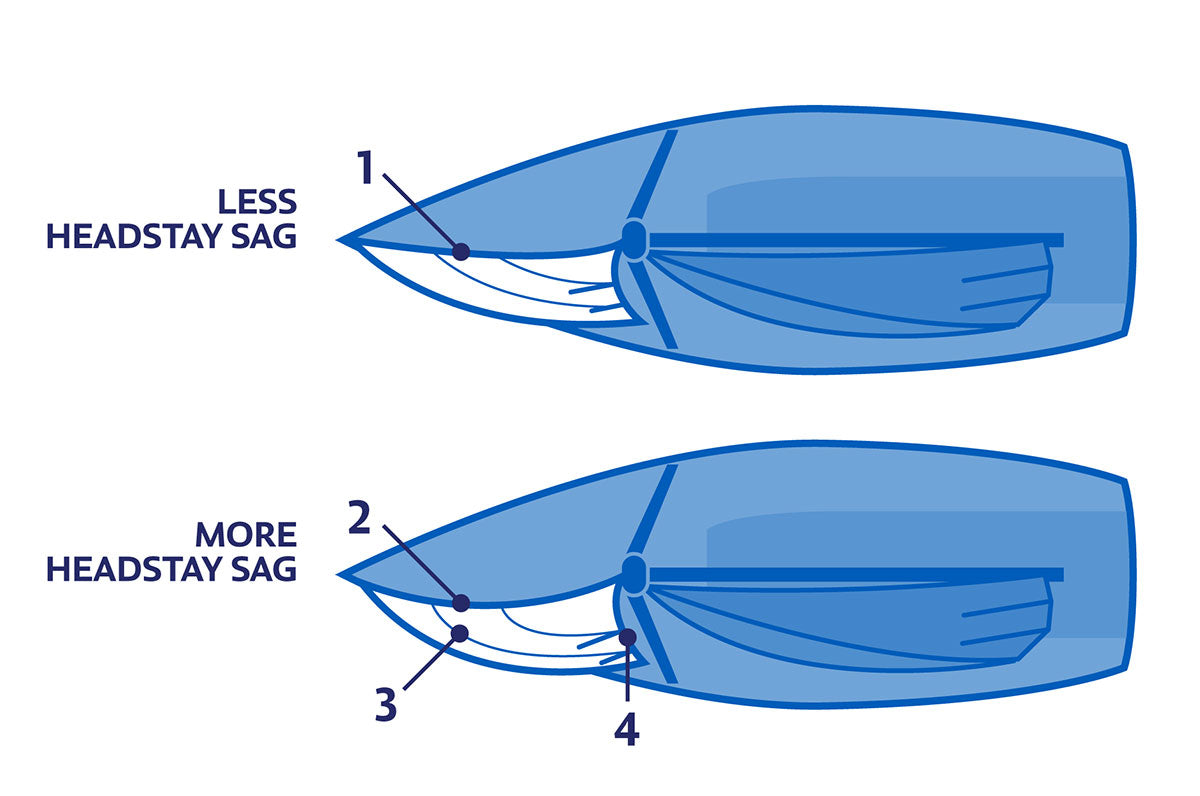J/70 LIGHT AIR HEADSTAY SAG & JIB TRIM
J/70 LIGHT-AIR HEADSTAY SAG & JIB TRIM
What do we look for in headstay sag to optimize jib trim for a variety of light-air conditions? One Design expert Tim Healy explains.

A couple of years ago, I sailed the Bayview One Design Regatta (BOD) in Detroit with Skip Dieball, the Etchells World champion that year. Skip knows a thing or two about making sailboats go fast and it was fun to interact with him and get his input and feedback on the J/70. I wrote an earlier version of this article after that regatta, and then reread the story last summer while we were preparing for the J/70 Worlds in Marblehead. The Worlds turned out to be windy, but we sailed two light-air regattas in Newport, RI, beforehand, and this reinforced and refined some of my ideas. I hope some of these notes can help you understand your J/70 setup better and help you go faster.
The regatta conditions that year in Detroit were largely light with occasional moderate chop, so rig tension, headstay sag, and jib trim were especially important factors in setting up the boat. Skip and I regularly discussed the synergy between these three variables to answer the question what should we look for in headstay sag on the J/70 to optimize jib trim through a variety of conditions? Afterwards, I gathered my thoughts on how one affects the other and how to tune and trim for maximum performance with a focus on light air, and I have augmented those with insights gained during 2018 summer racing.
How J/70 headstay sag improves pointing:
- The shrouds should be tensioned so that we have 2-4 inches of headstay sag at the mid-stripe of the jib and 1/2 to 3/4 inch of mid-mast side sag. The basic idea is that headstay sag adds depth to the jib.
- Adequate headstay sag in light to moderate wind reduces the need for weather sheeting the jib. Sagging the headstay powers up the middle of sail, but fine tuning the lower section is important. Tension the weather sheet so that the clew is just above the edge of the cabinhouse to 2” off the cabinhouse. In flat water, you can trim 1” inside the cabin house edge, maximum.

- The mast side sag is an indicator that the mast is free to move/flex with little restriction by the lowers. This will allow the mast to be more flexible and dynamic in light air and increase headstay sag.
- The middle of the jib luff sags not only aft but also to leeward, which changes your angle of attack to the wind.
- At the same time, the mid-leech “rotates” slightly to weather, reducing the need for windward sheeting referred to above.
The net result of the headstay sag is that the boat can point higher. So how do we get there consistently?
Light Air & Flat Water
In light air and flat water, it is important to create the power in the sail plan that the J/70 wants, while keeping flow across the sails. In lighter conditions and flat water, the jib needs depth for added power and sagging the headstay is the easiest and most direct method to create depth in the jib.
When the headstay sags, it not only sags to leeward but also sags aft, towards the jib tracks, which puts the luff closer to the leech, thereby adding depth to the jib. What we find is at the middle section of the jib, when it is sagging 4-6″, the luff of the jib is actually falling off to leeward slightly and the leech, by default, “rotates” to windward just a bit. This creates a scenario where the middle of the jib luff has a better angle of attack to the wind and, because of this better angle of attack, you will be able to point slightly higher without luffing or losing flow over the front of the jib.
In this scenario, when the mid -leech “rotates” to windward, the effect reduces the need to windward sheet as aggressively because the leech has, effectively, moved inboard already because of the sag.
When you have this setup correctly, it is still important to make sure the jib leech tell tales are flowing 90%-100% of the time so that the airflow stays attached to the jib, and the sailplan does not have any “breaks” or “stalls” in the airflow. That said, it is OK (and actually encouraged) to test to make certain you are at maximum trim by sheeting in periodically until you see the jib leech telltales stall slightly, then ease out till they are full streaming. This is your jib sheet trim range which may be as little as 1” of sheet.
It is important to stay on top of your rig tensions in these conditions and find the settings that work best for your rig and driving style. In general, rig tensions that are loose enough to create 4″ of sag are good for light air and flat water. As you can see in the tuning guide, the “base” setting is 16/10 minus 2 turns on the lowers for 10 knots so when the breeze is quite light (0-6 knots), I will loosen 1-2 turns on the uppers and between 1-2 turns on the lowers. This gets my uppers closer to 14 and the lowers are very loose (they do not register on the gauge). The mast side sag at the spreaders should be about a 1/2 inch when the lowers are loose enough. This side sag is also a signal that the mast is free to bend forward as well as off to the side. This forward bend is good in light air to create a flatter main that can be sheeted tighter without stalling the leech. This will also help pointing ability.
Light Air & Choppy Water
When chop is introduced into the picture, a loose rig is still good, but you may find that the rig will pump too much in heavy chop. This is normal, but in order to temporarily stabilize the rig, pull on enough backstay to take the deflection out of the backstay flicker at the top of the mast and put a small amount of tension to pull back on the mast. This should minimize the pumping of the rig and headstay and keep a more consistent sail shape through the chop. As soon as the patch of chop is over, release the backstay to get slightly more sag back in the headstay.
Final Thoughts
The J/70 is one of the few boats where weather sheeting is effective, but it has to be done with an eye on the headstay sag. With a saggy headstay, you will tend to use less weather sheet. With a tight headstay, in general, you can use more weather sheet. Keep in mind that the angle of attack and leech position will change with the headstay sag, and adjust your weather sheet accordingly.
These are tips that can make a big difference in light air speed. Feel free to contact Tim Healy or any member of the North Sails One Design Team if you have other questions on how to make your J/70 boat GO BEYOND.
For more on this subject, read “Why is Headstay Sag Fast Upwind?”
For more on the J/70, read “J/70 Speed Guide.”






